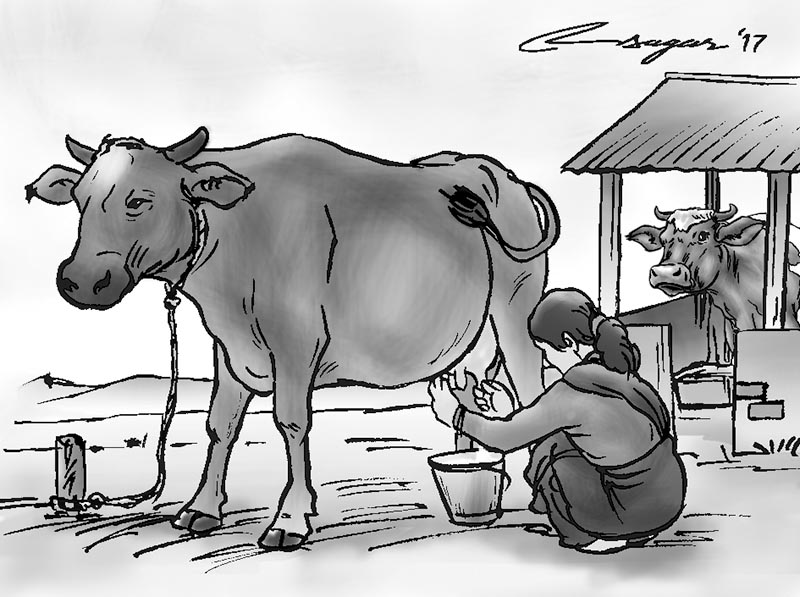Livestock farming: To enhance the economy
It is high time to restructure and revitalize the present institutional set-up in the livestock sector, enhance institutional level efficiency and promote new institutional models to handle the emerging challenges in livestock sector development
Livestock rearing in Nepal is highly segmented. Vast majority of livestock producers belong to the under-privileged section of the rural community and need a livestock development and research paradigm to achieve sustainable development. This section represents a sizeable population of rural families which contributes substantial livestock produce. Livestock are important in their livelihood and culture and they have limited alternative opportunities for employment. Studies show that development of small holders’ mixed crop-livestock production is one of the most effective methods of poverty alleviation.
In contrast the resources-rich section of the rural population also utilizes livestock development for optimizing their wealth. This section has the means and ability to obtain the desired variety of livestock and services needed to harness them. From the point of view of the national economy as well as exports, output of resource-rich segment of the population is also important.
The under-privileged livestock producers face a number of constraints. Their access to modern livestock services, especially veterinary services, is poor. The prices received by them for their products are low. For example, majority of milk producers get only 50 per cent of the price paid by consumers. Credit support for purchase of animals and its maintenance is not easily available to the small holders. Goats, pigs and backyard poultry are most commonly kept by the underprivileged, and these get very little development/research support. Improved animals that would “niche well” with the system of the underprivileged and adverse agro-ecological conditions in which majority of them live, particularly the ecologically fragile, are not available. There are hardly any programmes to assess their needs and produce or make available such animals. Feed fodder availability is a major constraint and conventional approach to improve the situation doesn’t work with the underprivileged.
The peri-urban production system has developed around cities and towns that have high demand for milk. The peri-urban dairy farmers rely mainly on purchased feed. They are commercially oriented and respond to improved technical inputs supply and marketing services. Milk is often traded directly to the consumers in the city and is the major source of income for the farmers.
Presently only a very small fraction of the livestock sector exists as an industrialized system. Examples include commercial poultry farming, dairy farms and a few goat and pig farms. While industrial systems permit reduction of cost of production due to economies of scale, their social, environmental and public health costs may prove extremely expensive in the long run.
Sustained rise in per capita income and urbanization are fueling rapid growth in demand for animal food products. Growth in demand is likely to be widespread cutting across class and regional distinctions. Demand for animal food products is income elastic and the low-income households with rise in their income will spend more on them. Though urbanization would continue to be the main driver of demand growth, rural areas will not lag behind. Besides, the world trade in livestock products has also been increasing fast implying opportunities for increasing exports. Livestock production has been growing faster than crop production and the momentum is likely to continue because of greater scope for development of the livestock sector. The demand-driven growth in livestock production will enable millions of poor to escape the poverty trap, as the distribution of livestock is more equitable as compared to land.
The extent to which growth in livestock production can be accelerated would depend on how technology institutions and policies address constraints facing the livestock sector. In the past growth in livestock production was largely number driven. The future growth should come from improvements in productivity. This will require overcoming feed and fodder scarcity and improvements in delivery of animal health and breeding services. Technology will be a key driver of growth and concentrated efforts will be needed to generate and disseminate yield-enhancing and yield-saving technologies. Public spending in livestock sector as a proportion of the value of sector’s output has fallen considerably over the last two decades. These need to be increased to re-energize the sector. Markets for live animals and their products are under-developed and dominated by informal traders who often exploit producers.
It is high time to restructure and revitalize the present institutional set-up in the livestock sector, enhance institutional level efficiency and promote new institutional models to handle the emerging challenges in livestock sector development. The efforts should aim to promote and nurture the grassroots level participatory bodies all over the country as the organic link between the animal husbandry department and the smallholders. It should also encourage and promote adoption of appropriate technologies, enhance productivity, increase effectiveness to the investment of time, energy and resources that small holders, particularly women, make for livestock development and management.
Karki is a veterinary health and management consultant.






